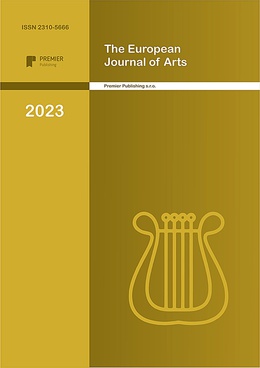Ways of maqam of the technique of ufar and forms and features in the composition of folk music
Authors
Rasulov Marufjon Mamirjon ogli

Share
Annotation
Purpose: specific features of Uzbek national music art, improvement of students' performance and technique in the correct style.
Methods: comparative, theoretical-analytical, generalization.
Results: it is necessary for pedagogues to pay attention to the further improvement of students' skills and talents in this subject, to ensure the disclosure of the unique aspects of styles and rhythmic changes, to control the acquisition of performance skills.
Scientific news: The main purpose of our scientific article is to reflect on the uniqueness of the Ufar techniques. Let us consider the functional aspects of the Ufar techniques, based on information about the forms and functions of folk music in the structure and status of musicologists, as well as techniques and conclusions tested in the practice of folk performance. In particular, the role, function and functionality of statuses are analyzed in the case of "Ufars", popular among the people and influential in nature. based on the methods shown for the first time in this article, specific methods of improving pedagogical skills in teaching students the character bases of rhythmic forms are defined.
Practical significance: theoretical and analytical materials presented in the article can be used in scientific works and educational processes. helps in practical lessons to improve performance technique.
Keywords
Authors
Rasulov Marufjon Mamirjon ogli

Share
References:
- Vyzgo T.S. To the question of the study of maqams. // Problems of musical culture of the peoples of Uzbekistan, Turkmenistan and Tajikistan. M., 1972
- Ibrohimov O. Hazrat Navoi and maqam. //Questions of musical creativity. Collection of articles II. Tashkent, 2002.
Karomatov F., Elnsner Yu. Maqam and maqam. //Music of the peoples of Asia and Africa. Issue 4. M. 1984.
- Kasimov R. Maqomat-people's need. Collection of articles and lectures "Lessons of Shashmaqam" T., 2005.
- Shashmaqam. Book. Tashkent. "Literary and art publishing house named after Gafur Ghulam", 1966.
- Shashmaqam. Book. Tashkent. "Literary and art publishing house named after Gafur Ghulam", 1967.
- Shashmaqam. Book. Tashkent. "Literary and art publishing house named after Gafur Ghulam", 1970.
- Shashmaqam. Book. Tashkent. "Literary and art publishing house named after Gafur Ghulam", 1972.
- Shashmaqam. Book. Tashkent. "Literary and art publishing house named after Gafur Ghulam", 1973.
- Shashmaqam. Book. Tashkent. "Literary and art publishing house named after Gafur Ghulam", 1975.
- Marufjon, R. (2022). A Matter of Rhythm in Oriental Classical Music. Pioneer: Journal of Advanced Research and Scientific Progress, 1(6), 80-84.
- Rasulov Marufjon Mamirjon Ogli and S. M. Begmatov. “THE ROLE AND SIGNIFICANCE OF RECEPTIONS IN MAQAMS (ON THE EXAMPLE OF RECEPTIONS OF THE STATE OF THE FERGHANA-TASHKENT DIRECTION)." Oriental Art and Culture 3.2 (2022): 810-821.
- https://scholar.google.ru/citations?view_op=view_citation&hl=ru&user=UZ7Sh6oAAAAJ&citation_for_view=UZ7Sh6oAAAAJ:2osOgNQ5qMEC
- Rasulov М. М., S. M. Begmatov THE ROLE AND SIGNIFICANCE OF RECEPTIONS IN MAQAMS (ON THE EXAMPLE OF RECEPTIONS OF THE STATE OF THE FERGHANA-TASHKENT DIRECTION) //Oriental Art and Culture. – 2022. – Т. 3. – №. 2. – р. 810-821.


